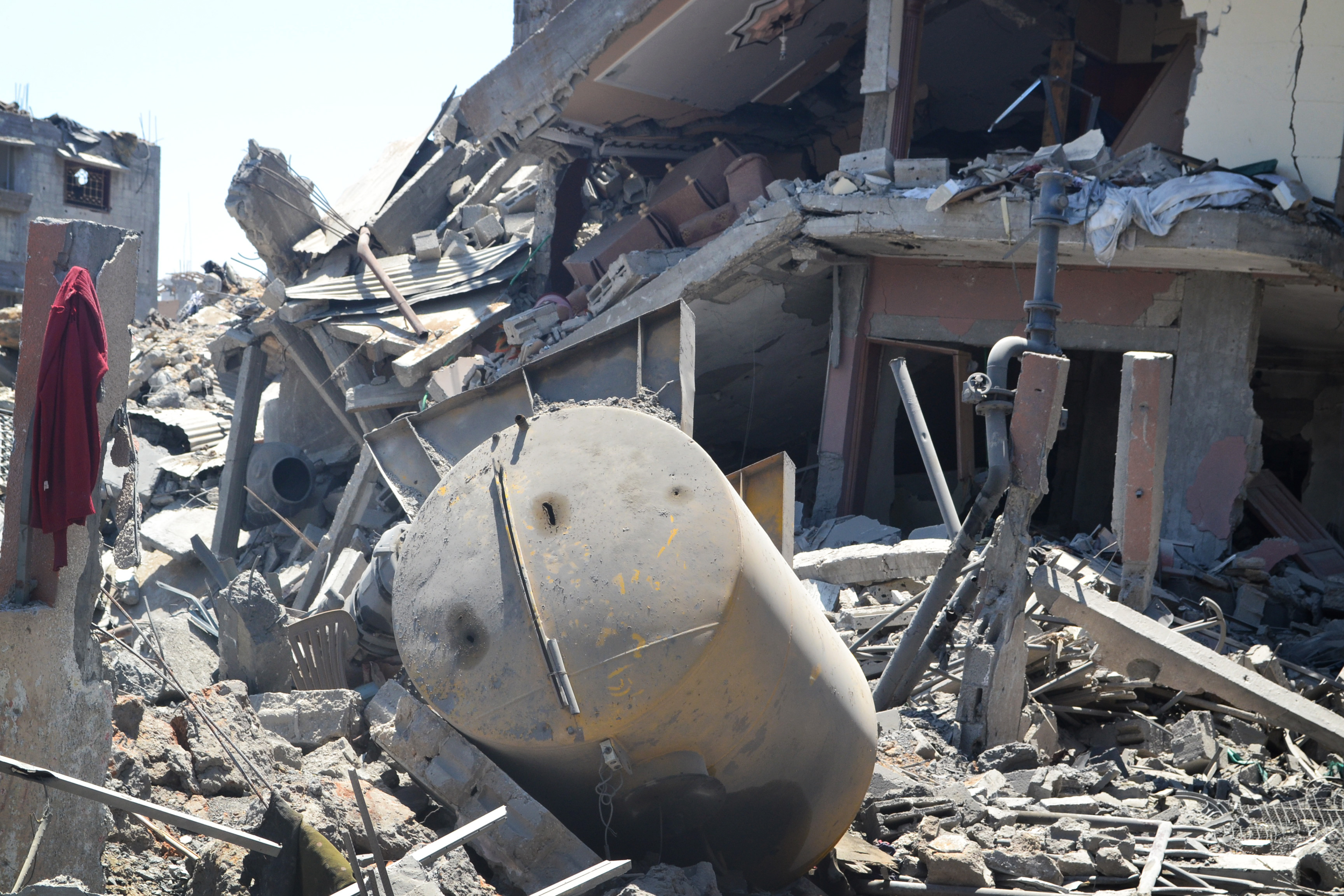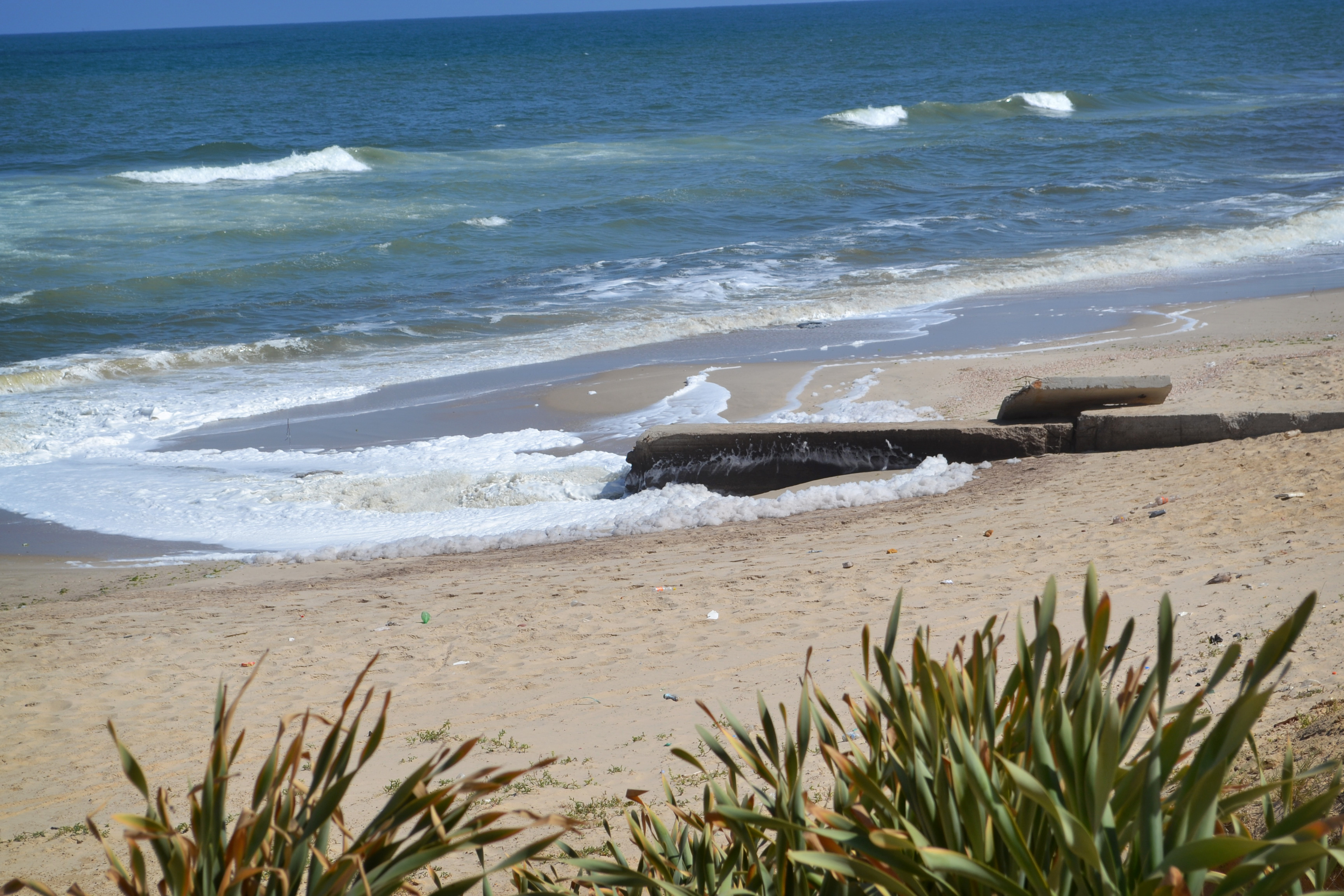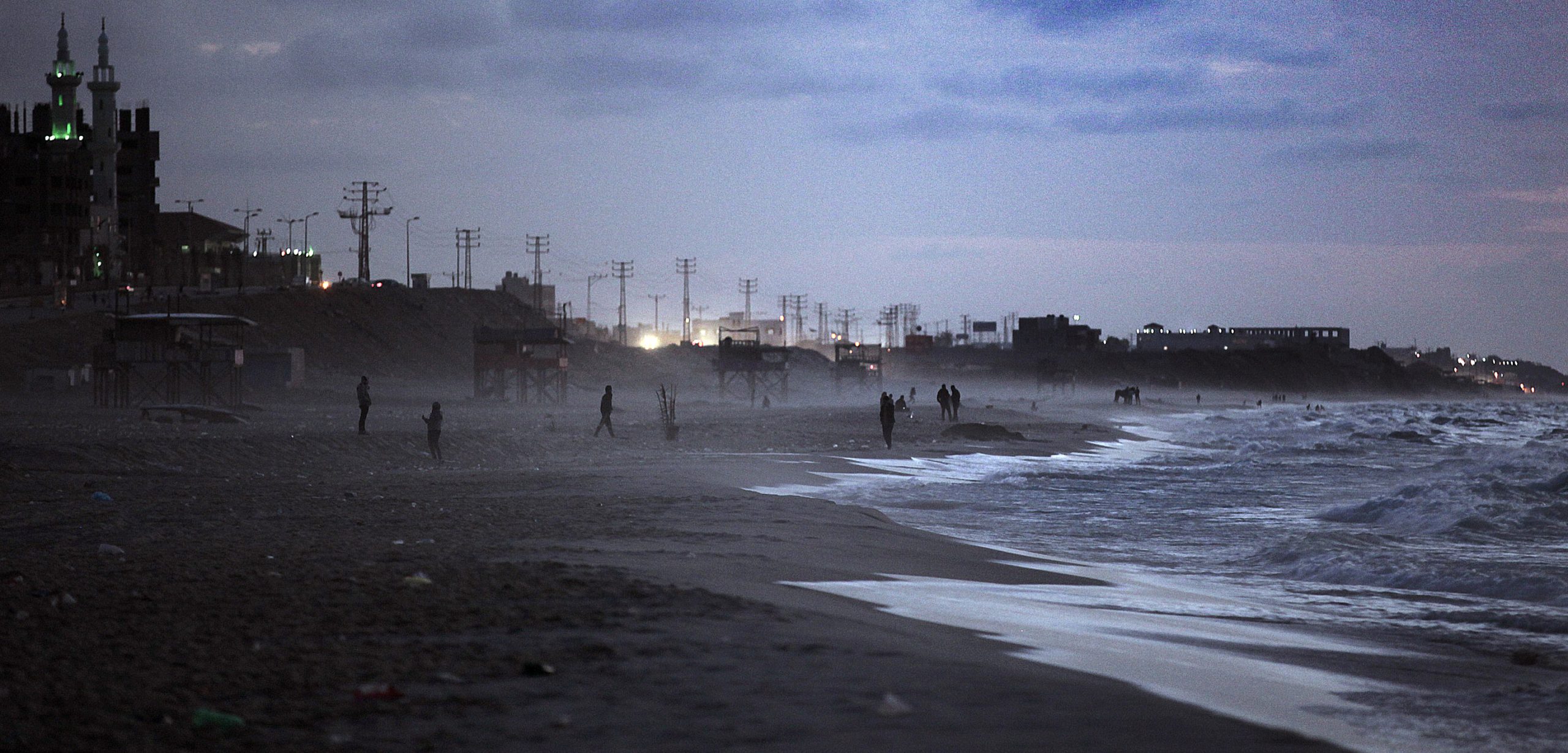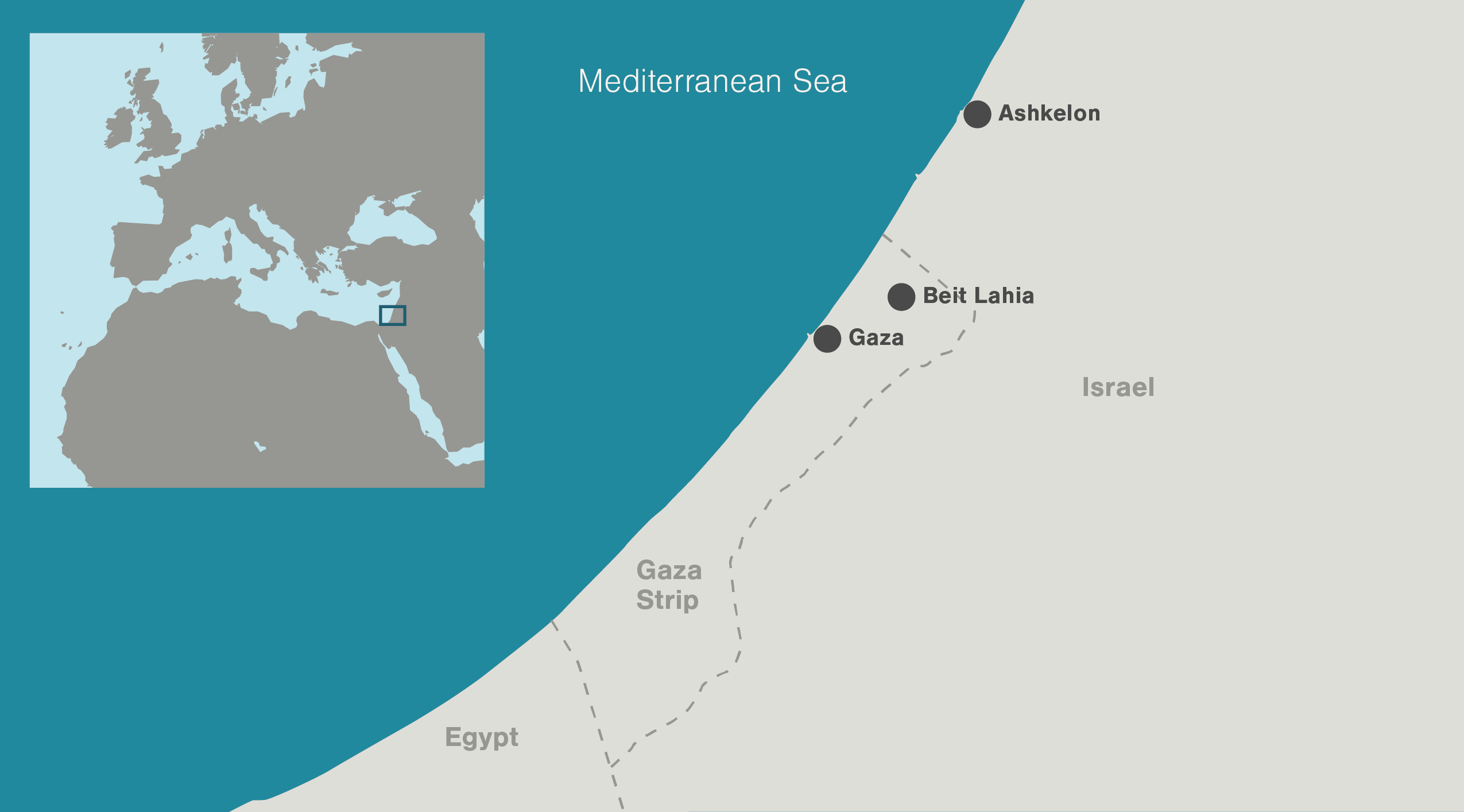Land Divided, Coast United
In Gaza and Israel, on the Mediterranean coast, a perennial optimist and an environmental organization work to overcome a border for the sake of sewage.
Article body copy
Congratulations to Josie Glausiusz on winning the 2015 Amnesty International Canada Media Award (Online Media) for this article.
Monther Shoblaq holds up a glass of water, takes a few gulps, and asks, “How do you see this glass—empty or full?” The 53-year-old engineer, speaking via Skype from the small, war-torn Gaza Strip, smiles and answers his own question. “If I’m not the kind of person who sees the full side of a glass of water, I would not keep running this system for the last 18 years.”
Shoblaq, a perennial optimist—“it’s my bad nature,” he jokes—leads a life that’s intricately linked to water: he is the general director of the Coastal Municipalities Water Utility in the Gaza Strip, the 40-kilometer-long, densely populated stretch of Palestinian territory sandwiched between Egypt and Israel on the Mediterranean coast.
Israel ruled from 1967 to 2005. In 2007, the militant Islamic organization Hamas took control. The two sides have clashed repeatedly ever since, making the job of running a water utility particularly difficult.
Gaza is home to 1.8 million people and it has a number of problems that transcend boundaries, including inefficient and inadequate sewage treatment plants, a shortage of electricity to operate them, and restrictions on the entry of construction materials for building new facilities. Gaza’s complex predicament has led to an unenviable solution: dumping over 90,000 cubic meters of raw or partially treated sewage into the Mediterranean Sea every day. That is the equivalent of 36 Olympic-sized swimming pools’ worth. While a bitter hatred separates the Israelis and Hamas—as does a security barrier running the length of the Gaza Strip—both peoples share the coastal waters and the putrid pollution swirling within them.
To add to Gaza’s woes, seawater is infiltrating the territory’s overexploited and polluted coastal aquifer, the region’s main drinking-water resource.
On this cold January morning, Shoblaq sits bundled in a sweater, his back to a satellite map of Gaza, his words briefly muffled by the sound of the muezzin calling Muslims to prayer. The genial, dark-haired father of five boys sighs: “I know that we are polluting the Mediterranean basin. But until I find a permanent solution for our sewage, I need to keep doing this … I don’t want to pollute the Mediterranean Sea, or the beaches, either. But they [Israelis] need to cooperate with us and allow us to finish what I started doing.”
One environmental group keen to cooperate is EcoPeace Middle East, an unusual organization in its ability to cooperate given the political climate. For 20 years, EcoPeace has brought together environmental activists from Jordan, Israel, and the Palestinian territories to work on regional issues such as water pollution and climate change. “Since we are an organization that focuses on cross-border water issues, it was very natural for us to take on this issue,” says Israeli director Gidon Bromberg.
In August 2014—in the midst of a bloody barrage when Israel and Gaza spent 50 days bombarding each other with air strikes and rocket attacks that killed more than 2,000 people in Gaza and 71 people in Israel—EcoPeace and the Institute for National Security Studies at Tel Aviv University published a detailed report entitled The Water, Sanitation and Energy Crises in Gaza: Humanitarian, Environmental and Geopolitical Implications. The authors warned Israeli decision-makers that preventing “the seeping time bomb of salinity and pollution deepening the humanitarian crisis in Gaza” was a moral responsibility and in Israel’s best interest.

A water well in Gaza destroyed during a recent conflict with Israel. Photo courtesy of Coastal Municipalities Water Utility
Understandably, Israel is also interested in preventing another kind of bomb threat—the rockets and mortars launched at the country, which tally over 12,500 since Hamas took control of the Gaza Strip—as the EcoPeace report notes. And during last summer’s war, Israeli forces uncovered a tunnel network built by Hamas to infiltrate the country; tunnels made with the aid of tens of thousands of tons of cement, gravel, and iron trucked into Gaza from Israel. To lessen these threats, Israel imposed further restrictions on the entry of dual-use materials into Gaza; that is, technology that could be used for military goals or peaceful aims such as sewage plant construction. That list, compiled by Israel’s Coordinator of Government Activities in the Territories (COGAT), includes missile equipment and munitions, but also drilling equipment, steel cables, concrete, water disinfection materials, and epoxy resin—the very equipment Shoblaq needs for the water utility. (Importing materials via the sea is not an option; Israel also controls the surrounding water access.)
EcoPeace’s report is meant to inform the Israeli public that, despite the dangers, they should care about sewage in the neighboring territory. Every day, trucks pump human waste from household cesspits in Gaza and then dispose of it in wadis, the dry riverbeds or streams that flow only during the rainy season. From there, this fetid ooze trickles down to the sea, polluting groundwater en route. In some areas, sewage pipes carry untreated human waste directly to the sea, emptying onto beaches where children play.
Faced with the enormity of the problem, Shoblaq raises his hands in despair. “[We have] no electricity, no spare parts. Gaza is closed,” he says. The territory produces about 150,000 cubic meters of sewage per day. And while the Gaza City Wastewater Treatment Plant was designed to treat up to 40,000 cubic meters of sewage per day, it now receives more than 60,000 cubic meters per day. “[It’s] like pushing an elephant inside a car,” Shoblaq says.
In northern Gaza, where most of the sewage is partially treated at the Beit Lahia Wastewater Treatment Plant, holding ponds breached their banks in 2008, flooding nearby neighborhoods and killing five people.
Beyond human tragedy, the limited sewage treatment in Gaza is also a missed opportunity. Even though the wastewater is treated at Beit Lahia, the salt content is high. “The water that we are consuming is saline, so the result is that the sewage is saline,” Shoblaq explains. “Agricultural farmers cannot accept the salty sewage, either.”
That means that, unlike Israel, a world leader in recycling sewage (85 percent of wastewater it produces each year is treated and repurposed for crop irrigation and industry), Gaza’s own valuable wastewater goes to waste. “Our goal as Palestinians in Gaza is to prevent any drop of sewage going into the ocean—it’s a national resource,” Shoblaq says. And untreated sewage that’s just dumped is a loss of money as well.
Were Israel and Gaza able to share such knowledge and expertise, their progress would be impressive. Even though their recent history is troubled, the two regions share many resources, including a sandy coastline settled by ancient cultures. Gaza and the coastal Israeli city of Ashqelon, only 13 kilometers northeast, were periodically conquered or colonized by Egyptians, Philistines, Assyrians, Greeks, Romans, Crusaders, the Ottoman Empire, and the British. During the Roman Period, both Ashkelon and Gaza exported fine wines to Egypt and Syria.
The two places are now worlds apart.
A 2012 report by Israel’s national water company, Mekorot, found less than half a percent of drinking water samples in Israel were contaminated by bacteria or parasites. Yet in Gaza, inadequacies in freshwater supply and sewage treatment have led to widespread water-borne infections. Today, about 72 percent of the population is serviced by a poorly maintained sewage system. A 2011 UNICEF report stated that water-associated illnesses account for about 26 percent of disease in Gaza, with diarrhea causing 12 percent of deaths among infants and young children in 2009. About half of the children in Gaza are infected with intestinal parasites, including protozoa and the giant roundworm Ascaris.
Dumping of untreated wastewater in the Mediterranean has another predictable consequence: an increase in organic matter. A 2014 report by Israel Oceanographic and Limnological Research found an increase in organic matter in seawater around Ashkelon and suggested that sewage from Gaza was a potential source.
“We know from research that we’ve done that anywhere where you have sewage emanating into the coastal environment, viable infectious microorganisms are released,” says microbiologist Dale Griffin of the United States Geological Survey St. Petersburg Coastal and Marine Science Center in Florida. “That can pose a risk to not only humans via recreational water use but also to marine mammals.”
Griffin, the lead author of a report on pathogenic human viruses in coastal waters, says that infectious organisms typically found in sewage include single-celled protozoans, such as Giardia and Cryptosporidium, as well as viruses transmitted by the fecal-oral route, including Coxsackie viruses, Hepatitis A, echoviruses, and the Norwalk virus. Some viruses can survive for a week in seawater, he notes, while Giardia and Cryptosporidium can persist for weeks, potentially months, because they form spores.
Contaminated seawater is worrisome for a country that relies on desalination plants for 40 percent of its freshwater needs. Israel’s first major desalination plant, in Ashkelon, only 13 kilometers from Gaza, keeps the Israelis vigilant. The potential for sewage to contaminate the desalination plant, “theoretically, can be a problem,” says engineer Shalom Goldberger, the former head of the environmental health department at the Israeli Ministry of Health. “We are really concerned about it.”

Gaza dumps more than 90,000 cubic meters of raw or partially treated sewage into the Mediterranean Sea every day. Photo courtesy of Coastal Municipalities Water Utility
That concern translates into thorough monitoring of the sea for viruses and bacteria in a zone about a kilometer square around the pumping point for the desalination plant. So far, that monitoring has calmed Israeli fears; in 10 years of desalination, the plant has detected no contamination from Gaza sewage. Desalination, Goldberger explains, is itself a form of treatment, since the water passes through fine membranes that exclude viruses and bacteria, and the desalinated water is chlorinated before it reaches the drinking water supply.
The most extraordinary part of this story is that Gaza actually has a newly constructed wastewater treatment plant—the North Gaza Emergency Sewage Treatment Project (NGEST)—but it has yet to open. Financed by the World Bank, with additional investment from European countries, NGEST is intended to replace the old Beit Lahia plant, the one that flooded the neighborhood. But NGEST “is standing there like a white elephant,” Bromberg says. The main problems? A power shortfall of three megawatts that Gaza has requested from Israel and lack of an essential chemical—hydrogen peroxide of a 30 to 35 percent concentration—which Israel will not allow past the border.
Gaza, with help from international funders, plans to add two wastewater treatment facilities—one in the south and another in the central part of the region—but those plans are delayed. It’s unlikely these two plants will open before 2017 or 2018, “under the most optimistic scenario,” according to the EcoPeace report.
The water utility needs equipment and materials such as pumps and steel. “A pump, for example, to the Israeli definition, could be a dual-usage,” says Shoblaq. “You can use it to pump water or to pump sewage. At the same time, the security people can define it as something you can use to dig a tunnel.” He smiles with resignation. “That’s why I laugh. It’s really hard to convince our Israeli counterparts in COGAT that I use this pump for a sewage pumping station.”
The situation is further complicated by the need for electrical power to operate the new NGEST plant. Gaza needs 452 megawatts of power. Right now, the power supply meets only 46 percent of the territory’s estimated needs. Gaza supplies itself with 40 to 60 megawatts, Egypt supplies up to 30 megawatts, and Israel about 125 megawatts. Therefore, rolling blackouts of eight hours or more per day are typical.
“In Gaza, we have only eight hours of electricity, then eight hours cut—even with three sources,” Shoblaq says. “So how can I treat sewage if there is only eight hours or 16 hours of electricity?” Since February, however, that’s been further reduced to six hours with electricity and 12 hours without.
The request for an extra three megawatts to run the unopened plant is itself the subject of controversy. According to Steen Lau Jorgensen, World Bank Country Director for the West Bank and Gaza, both the Palestinian Water Authority and the Palestinian Energy Authority have asked Israel for the three-megawatt supply and another six to seven megawatts to treat wastewater for use in irrigation. The Israeli authorities, Jorgensen says, “have so far not agreed to additional electricity supply to Gaza.”
In a written statement, the spokesperson for COGAT countered that, “Gaza does have adequate sewage treatment facilities. The problematic state of sewage in Gaza is a direct result of an insufficient supply of electricity due to insufficient funding from the Palestinian Authority.”
The spokesperson continued: “COGAT is working on a number of initiatives to rectify the situation at hand.” These include plans to convert Gaza’s power plant to operate on natural gas instead of diesel fuel and to connect Gaza to natural gas from Israel, which would reduce the price of electricity and support effective sewage treatment. Cooperation is possible: Israel does in fact supply 125 megawatts of power to Gaza via 10 power lines, and also sells Gaza five million cubic meters of water per year through two pipelines.
The COGAT representative also wrote that the organization was deeply involved in the establishment of NGEST, and that it works daily on civilian issues, such as sewage and infrastructure, with Palestinian counterparts, “… in order to create a cleaner and brighter future for all inhabitants of the region.”
A clean, bright future is one for which EcoPeace advocates as well. That future, it says, could begin tomorrow with some simple interim measures: Israel and the Palestinian Authority could agree to doubling the water supply to Gaza by opening a newly completed pipeline connection from Nahal Oz in Israel to northern Gaza, and Israel could jump-start the opening of NGEST by increasing the supply of electricity.
Bromberg is optimistic that change will come. “Our strength, in everything that we do, is that we do not say to Israelis that they need to do a favor to the neighbors,” Bromberg says. “We work for regional interests. We convince people that it is their own best interest to cooperate with the other side.”
Cooperation is key because water, which belongs to nobody and everybody, connects us all, even in a land riven by religious conflict. In the face of this strife, it is his own religious faith from which Shoblaq draws his hope. “I’m the kind of person who sees life from another perspective,” he says. “It does not belong to us, the life. It belongs to God. I know that God will not leave us without solutions. Otherwise, why are we born into this world?”


